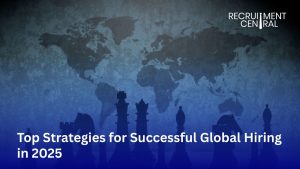Acquiring talent is one of the most crucial aspects of any business operations. The HR department contains varying experts on their panel to get demands from operations, talent hunt, reach out, shortlist and onboard best suitables to take the dreams forward.
The process is not complicated but in these times of the internet and numerous platforms posting job ads, employers and employees both are confused. But still there is a way and that one is conventional one best blended with technology, we will discuss in this post.
Also Read: How Small Businesses Can Hire Employees on a Budget
Simple Steps In Direct Hiring Process
1. Know The hiring need
The hiring process starts by identifying a need within different teams of your organization. Requirements mostly vary from filling a vacated position, better distributing a team’s workload, or expanding the scope of organizational tasks.
2. Craft A Recruitment Plan
After the requirement has been identified for a specific role, the next step is to form job roles and responsibilities for the same. In the case of newly created positions, operations must clearly download to the HR on how the new role must align with their goals and purpose. You can simply start with planning how to run announcements on the new position, both internally and externally, set criteria for phases of candidate screening, how the interview process will proceed and the team involved in that .
3. Make Job Descriptions
Next crucial step is to get a job description from the operations team and ask them to include a prioritized list of job skills, special qualifications, desired characteristics, and relevant experience. The job description must not be generic and later you can enhance it by including factors like regarding salary and benefits.
4. Advertising & Announcements
Experts suggest that you must start by notifying your existing workforce. Most of the time the whole task and cost of advertising the job stops there. If, however, you don;t find a right fit then go on external platforms. Leveraging several online platforms and word of mouth could be your best options to let the people know about it.
5. Review & Shortlist
Using the existing mechanism in place to get applications via email, an applicant tracking system (ATS), etc and later reviewing and shortlisting them. After you have shortlisted a batch of best options of qualified applications, the hiring team must review the remaining candidates and schedule the interviews.
6.Initial Screening
Initial interviews start with introductory calls with HR representatives. This stage only is enough to determine if candidates possess the required qualifications to match the position and align with an organization’s scope, culture and values.
7. Final Interviews
It varies and depends upon the type of industry the company is in and the size of the organization and the process set by the hiring committee. Single or multiple rounds could be scheduled with candidates. Final interviews mainly include conversations with the company’s senior management or a more in-depth specific/generic discussion with an interviewer from the initial stage.
8. Applicant Assessment
After the interviewing process is completed, the company must assign applicants with one or more standardized tests. These assessments help to measure a wide range of variables which includes personality traits, problem-solving ability, team-building skills, reasoning, reading comprehension, emotional intelligence, and more.
9. Background Check
Background checks are intended to review candidates’ history, verify employment history, any criminal records and eligibility, and also run credit checks.
10. Decision
After the background and the reference checks are completed the hiring staff then only identifies the ideal fits. Experts also suggest that hiring staff must also create a backup, in case the selected candidate fails the background check or they settle on no negotiations or in case of no show.
11. Job offer
The offer letter must be forwarded to the selected ones as soon as possible,a s you have been considering multiple ones for a single position, they might also have been in interviews with many. The HR team must decide internally which elements of the offer letter are negotiable, and which are not and then share with the candidate.
12. Onboarding
Onboarding the newly hires must be in a welcoming and professional way as it will help them get integrated in a desired manner. A well designed orientation program must be included as a part of the onboarding process, which ensures that your employee has a clear understanding of the expectations, the scope and their purpose of being with you.
Also Read: The Future of Global EOR Services in Business Expansion
Tips For Recruiters While Hiring Directly
Following the process is one thing, but staying updated and taking care of some small yet crucial details could help you better maneuver;
1. Experience
If candidates have pertinent and desired experience for the specific or even for the similar roles, they are likely to get you to achieve the success in your team.
2. Potential and Passion
Many times you get candidates who are not experienced but are dedicated enough to learn and drive. They might be a suitable choice for your team as they are eager and quick to learn which mainly is while switching careers and this also provides you to lead the negotiation.
3. Hard skills
Hard skills are generally considered ones which are measurable, technical skills that candidates have acquired in school or learnt with past jobs. In case, if you are hiring civil engineers, it can be helpful to select candidates with experience in computer-aided designs and similar softwares
4. Soft skills
Soft skills are the ones which come into the interpersonal category that help a candidate perform their duties efficiently. For instance, some of the most generous soft skills for professionals are teamwork, communication, critical thinking, decision-making and ability to solve problems.
Conclusion
Hire as per your operation demands and never substitute cost with skill and talent. Many organisations set foundations on dull facts like, they can hire three employees in one particular salary slab of a single employee, but they fail to understand the amount of skills, talent and experience that specific staff member is bringing with them. It takes them years to train and comprehend the new ones to reach on that level, yet they don’t deliver up to satisfactory level







